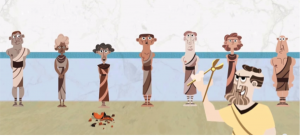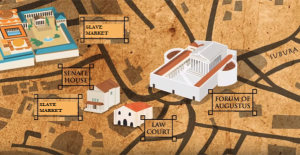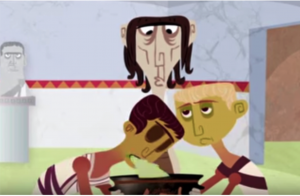
In the story of The Four Sisters in Ancient Rome, the slaves of the house of Lucius Domitius Ahenobardus were waiting anxiously for their master to return home, wondering who would be punished for the breaking of an expensive dish. This scene is just a glimpse into the vulnerable existence of Roman slaves. Who were these people who were under the complete subjection of their Roman owners? What were their lives like? The best answers to these questions can be found by looking back at what was written about slaves by ancient authors. The topic is a large one and in order to gain a full understanding of this significant portion of Ancient Rome’s population this blog will be presented in two parts.
Contents
1. What did it mean to be a slave in Rome?
2. Capture/ birth into slavery/exposure
3. Sale of a slave
4. Working life of a slave
![]()
What did it mean to be a slave in Rome?
In the second century AD, jurist Gaius explains how inhabitants of the Roman Empire were defined by Roman law:
Gaius
The primary distinction in the law of persons is this, that all men are either free or slaves. Next, free men are either ingenui (freeborn) or libertini (freedmen). Ingenui are those born free, libertini those manumitted from a lawful slaver.
(Gaius, Institutes 1.9-11)
In order to understand the life of a slave in Ancient Rome it is necessary to look at what ancient sources tell us, as well as what can be understood from archaeology and surviving images. Most written sources regarding slavery were written by masters, not slaves. The only exceptions were Phaedrus, a freed slave of the emperor Augustus (early 1st century AD) who wrote fables and Epictetus, a philosopher and former slave (mid- to late 1st century AD).
Phaedrus
Phaedrus explains in a prologue to a book of fables the origins of the genre:
In a few words I now propose
To point from whence the Fable rose.
A servitude was all along
Exposed to most oppressive wrong,
The suff’rer therefore did not dare
His heart’s true dictates to declare;
But couch’d his meaning in the veil
Of many an allegoric tale,
And jesting with a moral aim,
Eluded all offence and blame
Phaedrus, Fables, III. Prologue
A fable is a short story in which animals, plants or objects take on human characteristics. Each tale has a moral. One of the most famous, which comes from the Greek fabulist Aesop, is the Hare and the Tortoise.
The Hare and the Tortoise
A HARE one day ridiculed the short feet and slow pace of the
Tortoise, who replied, laughing: “Though you be swift as the
wind, I will beat you in a race.” The Hare, believing her
assertion to be simply impossible, assented to the proposal; and
they agreed that the Fox should choose the course and fix the
goal. On the day appointed for the race the two started
together. The Tortoise never for a moment stopped, but went on
with a slow but steady pace straight to the end of the course.
The Hare, lying down by the wayside, fell fast asleep. At last
waking up, and moving as fast as he could, he saw the Tortoise
had reached the goal, and was comfortably dozing after her
fatigue.
What is the moral of the story?
Slow but steady wins the race.
According to Phaedrus, a slave who is oppressed can disguise his moral message within a fable so that he his not punished for expressing discontent with his life as a slave or for mocking his master.
Plautus
Plautus, a playwright of the 2nd and 3rd centuries, was not a slave or former slave, but in his comedies are slave characters who give some perspective on what it meant to be a slave. One slave character, Messenio, describes life working in a grain mill:
MESSENIO to himself.
This is the proof of a good servant, who takes care of his master’s business, looks after it, arranges it, thinks about it, in the absence of his master diligently to attend to the affairs of his master, as much so as if he himself were present, or even better. It is proper that his back should be of more consequence than his appetite, his legs than his stomach, whose heart is rightly placed. Let him bear in mind, those who are good for nothing, what reward is given them by their masters–lazy, worthless fellows. Stripes, fetters, the mill, weariness, hunger, sharp cold; these are the rewards of idleness. This evil do I terribly stand in awe of. Wherefore ’tis sure that to be good is better than to be bad. Much more readily do I submit to words, stripes I do detest; and I eat what is ground much more readily than supply it ground by myself. Therefore do I obey the command of my master, carefully and diligently do I observe it.
Plautus, Menaechmi
Capture/ Birth into Slavery/Exposure

The Roman Empire at the height of expansion
From the mid-3rd century BC Rome experienced a large increase in its slave population through overseas expansion and enslavement of foreign populations. In the Justinian Digest, a 6th century AD compilation of Roman laws, we learn how people fell into the state of slavery in the Roman Empire:
Justinian’s Digest
Slaves are brought under our ownership either by the Civil Law or by that of Nations. This is done by the Civil Law where anyone who is over twenty years of age permits himself to be sold for the sake of sharing in his own price. Slaves become our property by the Law of Nations when they are either taken from the enemy, or are born of our female slaves.
Digest 1.5.5.1
As defined by this source, the slaves of Rome came from three sources: the first were individuals who had sold themselves into slavery; the second source came from those captured in war, and finally, those who were born of slaves. A person who was captured and sold into slavery was considered lost forever:
In every branch of the law, a person who fails to return from enemy hands is regarded as having died at the moment when he was captured.
Digest 49.15.18
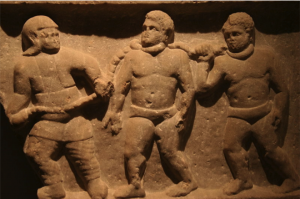
Roman collared slaves. — Marble relief, from Smyrna (Izmir, Turkey), 200 CE. Collection of the Ashmolean Museum, Oxford, England.
One other source of slaves in the Roman Empire was through the practice of exposing unwanted infants. There is insufficient evidence to determine the number of slaves who were picked up by slave traders as infants, but it could have been a significant contribution to the slave population (See Madden, Slavery in the Roman Empire: Numbers and Origins) There are no accounts surviving of exposing infants, but the founding myth of Rome provides an insight into both exposing infants, and the possibility of survival.
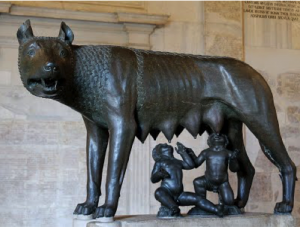
‘She-Wolf’ suckling Romulus and Remus (Capitoline Museums, Rome)
Livy
THE STORY OF ROMULUS. Birth and Uprearing.
Vestal was forcibly violated and gave birth to twins. She named Mars as their father, either because she really believed it, or because the fault might appear less heinous if a deity were the cause of it. But neither gods nor men sheltered her or her babes from the king’s cruelty; the priestess was thrown into prison, the boys were ordered to be thrown into the river. By a heaven-sent chance it happened that the Tiber was then overflowing its banks, and stretches of standing water prevented any approach to the main channel. Those who were carrying the children expected that this stagnant water would be sufficient to drown them, so under the impression that they were carrying out the king’s orders they exposed the boys at the nearest point of the overflow, where the Ficus Ruminalis (said to have been formerly called Romularis) now stands. The locality was then a wild solitude. The tradition goes on to say that after the floating cradle in which the boys had been exposed had been left by the retreating water on dry land, a thirsty she-wolf from the surrounding hills, attracted by the crying of the children, came to them, gave them her teats to suck and was so gentle towards them that the king’s flock-master found her licking the boys with her tongue. According to the story his name was Faustulus. He took the children to his hut and gave them to his wife Larentia to bring up. Some writers think that Larentia, from her unchaste life, had got the nickname of “She-wolf” amongst the shepherds, and that this was the origin of the marvellous story.
Livy, The History of Rome 1.4
Dionysius of Halicarnassus
Exposing unwanted infants was a significant enough of a problem that a law was passed to help prevent it:
Romulus sufficiently regulated and suitably disposed the city both for peace and for war: and he made it large and populous by the following means. In the first place, he obliged the inhabitants to bring up all their male children and the first-born of the females, and forbade them to destroy any children under three years of age unless they were maimed or monstrous from their very birth. These he did not forbid their parents to expose, provided they first showed them to their five nearest neighbours and these also approved.
Dionysius of Halicarnassus, Roman Antiquities, 2.15
Note the law stipulates only the first female child to be born had to be cared for, subsequent female children could be abandoned after they were three. Once children were three however, it was thought parents would be reluctant to part with them.
Sale of a slave
Slaves captured in war would eventually find themselves in the slave markets of the Empire. In the city of Rome there were two such markets. One was located behind the senate house in the Forum and a second, for more specialised slaves, was near the Saepta Julia in the Campus Martius. Ancient sources detail the humiliation suffered by slaves in these markets:
Seneca
When you buy a horse, you order its blanket to be removed; you pull off the garments from slaves that are advertised for sale, so that no bodily flaws may escape your notice; if you judge a man, do you judge him when he is wrapped in a disguise? Slave dealers hide under some sort of finery any defect which may give offence, and for that reason the very trappings arouse the suspicion of the buyer. If you catch sight of a leg or an arm that is bound up in cloths, you demand that it be stripped and that the body itself be revealed to you.
Seneca, Letters 80.9
Horace
1st century BC poet Horace even leaves us with an example of what a slave dealer would say at the market to advertise his merchandise.
Here’s a handsome lad, lovely from head to toe,
Eight thousand sesterces and it’s done, he’s yours,
Born in-house, quick to obey his master’s orders,
Trained in Greek letters, adaptable to any task,
Wet clay that can be moulded however you wish:
He’ll even sing as you drink, artlessly but sweetly.
…no one will easily see the like from me.
He’s only skipped once, as they do,
And hid under the stairs fearing the strap on the wall.
Horace, Letters 2.2.1-19
The slave dealer tells the buyer of the slave’s abilities, making them sound attractive, while not overtly lying. The boy has studied Greek but he does not say he can speak Greek. He can sing but is not trained. He is also careful to assure the potential buyer that this slave will not run away giving the example that when afraid the boy merely hid from his master, but did not try to run.
Working life of a slave
It was possible for a slave to work in almost any position, except in positions of government. This being so, the working life of a slave could vary considerably. From ancient sources it is clear that the most difficult lives were suffered by slaves who worked in mines or quarries.
Diodorus Siculus
…to continue with the mines, the slaves who are engaged in the working of them produce for their masters’ revenues in sums defying belief, but they themselves wear out their bodies both by day and by night in the diggings under the earth, dying in large numbers because of the exceptional hardships they endure. For no respite or pause is granted them in their labours, but compelled beneath blows of the overseers to endure the severity of their plight, they throw away their lives in this wretched manner, although certain of them who can endure it, by virtue of their bodily strength and their persevering souls, suffer such hardships over a long period; indeed death in their eyes is more to be desired than life, because of the magnitude of the hardships they must bear.
Diodorus Siculus 5.38.1
Work in the fields and particularly in the mills was also gruelling for slaves. Writer Apuleius (2nd century AD) describes what is seen by one of his characters in a Roman mill:
Apuleius
…what a pack of dwarves those [mill] workers were, their skins striped with livid welts, their seamed backs half-visible through the ragged shirts they wore; some with loin-cloths but all revealing their bodies under their clothes; foreheads branded, heads half-shaved, and feet chained together. They were wretchedly sallow too, their eyes so bleary from the scorching heat of that smoke-filled darkness, they could barely see, and like wrestlers sprinkled with dust before a fight, they were coarsely whitened with floury ash.
Apuleius, Metamorphoses 9.12.13
A Roman household needed many servants to care for the family and the house. These domestic slaves generally had a higher quality of life than those who laboured in the fields, mills, mines or other labour-intensive jobs. Insight into the life of a domestic slave has been left by Seneca.
Seneca
When we recline at a banquet, one slave mops up the disgorged food, another crouches beneath the table and gathers up the left-overs of the tipsy guests. Another carves the priceless game birds; with unerring strokes and skilled hand he cuts choice morsels along the breast or the rump. Hapless fellow, to live only for the purpose of cutting fat capons correctly – unless, indeed, the other man is still more unhappy than he, who teaches this art for pleasure’s sake, rather than he who learns it because he must. Another, who serves the wine, must dress like a woman and wrestle with his advancing years; he cannot get away from his boyhood; he is dragged back to it; and though he has already acquired a soldier’s figure, he is kept beardless by having his hair smoothed away or plucked out by the roots, and he must remain awake throughout the night, dividing his time between his master’s drunkenness and his lust; in the chamber he must be a man, at the feast a boy. Another, whose duty it is to put a valuation on the guests, must stick to his task, poor fellow, and watch to see whose flattery and whose immodesty, whether of appetite or of language, is to get them an invitation for to-morrow. Think also of the poor purveyors of food, who note their masters’ tastes with delicate skill, who know what special flavours will sharpen their appetite, what will please their eyes, what new combinations will rouse their cloyed stomachs, what food will excite their loathing through sheer satiety, and what will stir them to hunger on that particular day.
Seneca, Letter 47
Some of these jobs can be related to the modern day (cooks and waiters) but others do not (what can we call the slave who keeps points of each guest based on how much they flatter the host and how they behave?). Seneca points out the difficulties of each of these jobs, and in particular highlights the sexual vulnerability of all slaves, both male and female. A slave was the property of his or her master, and was subject to both physical and sexual abuse.
